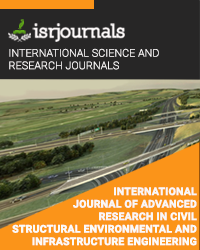removal of zinc from barrel plating wash water by electro coagulation using aluminium as anode and stainless steel as cathode
S.Kalaivani,S.Ananthalakshmi
Published in International Journal of Advanced Research in Civil,Structural,Environmental and Infrastructure Engineering and Developing
ISSN: 2320-723X Impact Factor:1.7 Volume:2 Issue:2 Year: 07 July,2014 Pages:112-120

Abstract
Heavy metals are generally refractory and cannot be de-toxified and de-graded biologically, hence it is a challenging task for the industrialist and environmentalist for the safe method for the effective disposal of waste containing heavy metals. Various technique which have been developed for the removal of heavy metal include chemical precipitation, reverse osmosis, bio-sorption etc. The electro coagulation method was widely used and playing an important role in the effluent treatment. Since electro coagulation process has better removal efficiency compared to chemical coagulation. The current topic is aimed for the removal of zinc as Zn2+. The main objective to the current work is to remove zinc from barrel plating wash water by electro coagulation using aluminium (Al) as anode and stainless steel (SS) as cathode. The scheme study involves: Effect of initial metal concentration (866ppm, 433ppm, 216.5ppm, 279ppm), Effect of pH (acid, alkali, neutral), Effect of current density(0.1A, 0.2A, 0.6A), Effect of supporting electrolyte (Nacl) concentration(2gpl, 4gpl), Effect of polarity change(AL-AL, MS-MS), Effect of different combination of electrodes(AL-SS, MS-SS) for the removal of zinc. The crystallographic orientation, identification of structure were analyzed by X-ray diffraction. The presence of different phases was analyzed by XPS analysis. In order to study the surface morphology and composition of coatings SEM and EDAX were used. The reduction of zinc in wash water has been determined by FT-IR spectrometer and HPLC. In particular the electro chemical techniques provide higher efficiency than conventional methods.
Kewords
Electroplating, Electro coagulation, Zinc, Barrel Plating.
Reference
[1] S.P.Mahajan, Pollution control in process industries, (1985), 263. [2] B. Smith, Pollutant Source Reduction: Part II – Chemical handling, American Dyestuff Reporter, 78, (1989) 30-32. [3] J.R, Provost, Journal of the Society of Dyers and Colourist, 108 (1992) 260-264. [4] A. SavaKoparal, ÜlkerBakir Ö. ütveren, Journal of Hazardous Materials, 89 (2001) 83-94. [5] T. Vengris R. Binkien, A. Sveikauskait, Applied Clay Science, 18(2001)183-190. [6] Jia-Qian Jiang, Nigel Grahamv, Cecile André, Geoff H. Kelsall, Nigel Brandon Water Research, 36 (2002) 4064-4078. [7] J. Gabelich, D. Tran, I. H. Suffet, Environ. Sci.Technol, 36(13) (2002)3010–3019. [8] P. Ratna Kumar, SanjeevChaudhari ,Kartic C. Khilar, S. P. MahajanChemosphere, 55(2002)1245-1252. [9] Guohua Chen, Separation and Purification Technology, 38(2004)11-41. [10] F.A.Abu Al-Rub, M.H El-Naas, F Benyahia and I .Ashour, ProcessBiochemistry, 39 (2004)1767-1773. [11] A. D browski, Z. Hubicki, P. Podkocielny, E.Robens, Chemosphere, 56(2004)91-106. [12] M. Murugananthan, G. BhaskarRaju, S. Prabhakar, Journal of Hazardous Materials, 109(2004)37-44. [13] NihalBektaş, SalimÖncel, Hilal Y. Akbulut andAnatholyimoglo, Environmental Chemistry Letters, 2(2004)51-54. [14] ChenL.Lai,Sheng H.Lin,Chemosphere54 (2004) 235-242. [15] C.Y. Hu, S.L. Lo, C.M. Li and W.H. Kuan, Journal of Hazardous Materials, 120(2005) 15- 20. [16] J. Paul Chen, L.L. Lim, Chemosphere, 60(2005)1384-1392. [17] Y. Fernández, E. Marañón , L. Castrillón, I. Vázquez, Journal of Hazardous Materials, 126 (2005) 169-175. [18] EfthaliaChatzisymeon, Nikolaos P. Xekoukoulotakis, Alberto Coz, Nicolas Kalogerakis, DionissiosMantzavinos, Journal of Hazardous Materials, 137 (2006) 998-1007. [19] A.K. Golder, A.N. Samanta and S. Ray, Separation and Purification Technology, (2006) 102-109. [20] Claudio Escobar, César Soto-Salazar,, M. Inés Toral, Journal of Environmental Management, 81(2006)384-391. [21] Ü. Tezcan, S. Uğur, A.S. Koparal, Ü. BakırÖğütveren, Separation and Purification Technology, 52(2006)136-141. [22] R.G. Casqueira, M.L. Torem, H.M. Kohler, Minerals Engineering, 19 (2006)1388-1392. [23] A. Verma, S. Chakraborty and J.K. Basu, Separation and Purification Technology, 50(2006) 336-341. [24] Henrik K. Hansen, Patricio Nuñez, Deborah Raboy, Italo Schippacasse, Rodrigo Grandon, ElectrochimicaActa, 52 (2007) 3464-3470. [25] Ivonne Linares-Hernández, Carlos Barrera-Díaz, Gabriela Roa-Morales,Bryan Bilyeu, Fernando Ureña-Núñez, Journal of Hazardous Materials, 144(2007)240-248 [26] Jewel A.G. Gomes, Praveen Daida, Mehmet Kesmez, Michael Weir, Hector Moren, Jose R. Parga, George Irwin, HyltonMcWhinney, Tony Grady, Eric Peterson, David L. Cocke, Journal of HazardousMaterials,139 (2007) 220-231. [27] A.K.Golder, A.N. Samantha, S. Ray, Separation and PurificationTechnology 53 (2007)33-41. [28] Sirajuddin, Lutfullah, Kakakhel, Abdul Niaz, Journal of HazardousMaterials 148(2007)560-565. [29] Othman, Fadil, M. Ni'am, F. Sohaili, J. Fauzia, water Science and technology, 56(2007)47-53. [30] R. Ramesh babu, N.S. Badrinarayana, K.M.MeeraSheriffa begum, N.Anantharaman Journal of the university of chemical technology and metallurgy, 42(2007)201-206. [31] Dinesh Mohan, and Charles U. Pittman,Journal of Hazardous materials, 142 (2007)1-53. [32] . IlonaHeidmann, Wolfgang Calmano, Journal of Hazardous Materials, 152 (2008)934-941. [33] A.Erdem, Yilmaz, M.MuhtarKocakerim, Journal of Hazard materials,153(2008)146-151. [34] RenuAhlawat,VimalchandraSrivastava,IndraDeoMall,ShiShir Sinha,Clean36(2008) 1-7. [35] C. Ahmed Basha, S. Josephine Selvi, E. Ramasamy, S. Chellammal.Chemical Engineering Journal, 141(2008)89-98. [36] Sevilveli, tuba öztürk, Anatoly Dimoglo, Separation and Purification Technology, 61(2008)82-88. [37] Mustafa Yavuz, Fisheyes Gode, ErolPehlivan, SemaOzmert, C. Sharma. Chemical Engineering journal, 137(2008)453-461. [38] I-Chun lin,Jiunn-kwei ,Li Ruey-shin juang.T.desalination, 225(2008)249-259 [39] Archana Mishra; Brahma D. Tripathi, Toxicological & EnvironmentalChemistry, 90 (2008)1091 – 1097. [40] B. Merzouk, B. Gourich, A. Sekki, K. Madani, M. Chibane, Journal of Hazardous Materials, 164(2009)215-222. [41] Işıkkabdaşlı, ,TülinArslan, TuğbaOlmez-hancı, IdilArslan-Alaton, OlcayTünay, Journal of Hazardous materials, 165(2009)838-845. [42] Tsz-Him Shek, Anthony,Vinci K.C. Lee, Gordon Mckay, Chemical Engineering Journal, 146(2009)63-70. [43] Bilge alyü, SevilVeli, Journal of Hazardous Materials, 167(2009)482-488. [44] Manpreet S. Bhatti, Akepati S. Reddy, Ashwani K. Thukral, Journal of Hazardous Materials, 172 (2009) 839-846. [45] Daniel R.Anjaneyulu, Krupadam, ZaštitaMaterijala 50 (2009) broj 1. [46] S.Mohan, R.Gandhimathi, Journal of Hazardous Materials, 169(2009) 351-359. [47] G. D. Silva J.R., Nayara Szymanski, Alexander D. kroumov and Daniela E.G. Trigueros., Chemical Engineering Journal, 151 (2009) 59-65. [48] K.S. ParamaKalyani, N. Balasubramanian,, C. Srinivasakannan, Chemical Engineering Journal, 151 (2009) 97-104. [49] SubramanyanVasudevan,Jothinathan Lakshmi, RamasamyVanathi, Clean-Soil, air, water, 38(2010)9-1.

